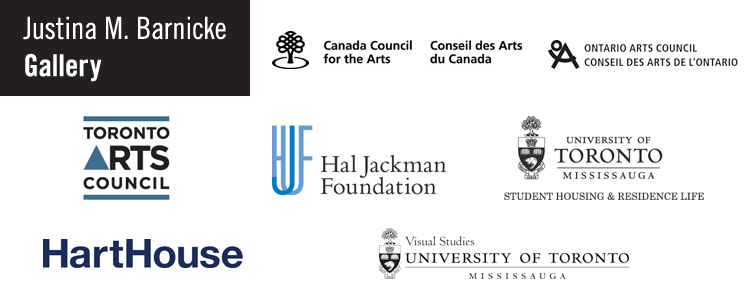
January 16 - March 10, 2013
Curated by Christof Migone
Co-presented with Justina M. Barnicke Gallery
At BLACKWOOD GALLERY:
Dave Dyment, Alexis O'Hara, Darsha Hewitt, John Oswald, Ian Skedd, Charles Stankievech
At JUSTINA M. BARNICKE GALLERY:
Mitchell Akiyama, crys cole, Marla Hlady, Neil Klassen, David Lieberman, Rafael Lozano-Hemmer, Sylvia Matas,
David Merritt, Ryan Park, Juliana Pivato, Alexandre St-Onge, Chiyoko Szlavnics, John Wynne


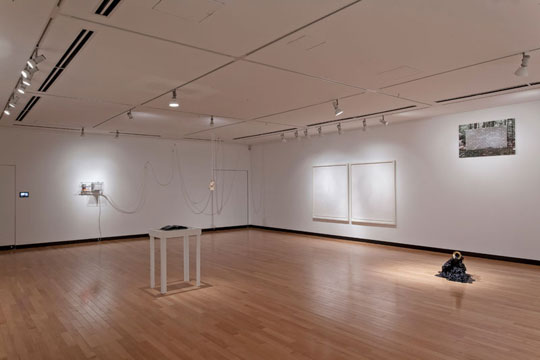
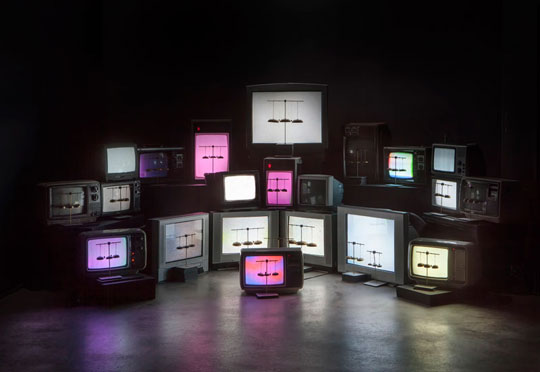
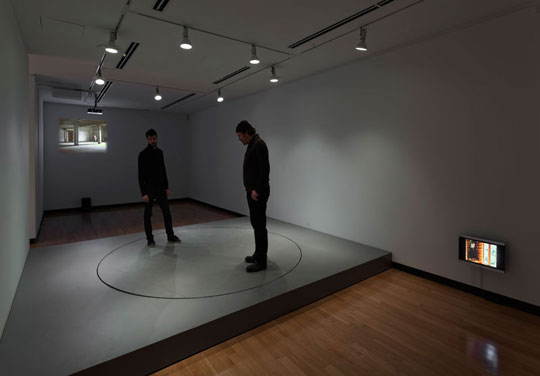
Opening Reception at Blackwood Gallery:
Wednesday January 16, 5 - 8pm
A FREE shuttle bus will depart at 5:30pm from Mercer Union (1286 Bloor Street W.) and return for 8pm. Artists will be in attendance.
Opening Reception at the Justina M. Barnicke Gallery:
Thursday January 17, 7 - 9pm
Artists will be in attendance.
SOUND BY ARTISTS: Book Launch and Panel Talks
Sunday February 3, 12 – 6pm
Music Room, Hart House, University of Toronto
Join us for a series of talks and come celebrate the launch of a facsimile edition of Sound by Artists (edited by Dan Lander & Micah Lexier), originally published in 1990 and now re-published by Blackwood Gallery & Charivari Press. Invited speakers and moderators include Seth Kim-Cohen, Martin Arnold, Dan Lander, Jim Drobnick, Marla Hlady, David Merritt, Juliana Pivato, Adi Louria-Hayon, Barbara Fischer, Nicole Gingras and Christof Migone.
For more information and updates, see below.
FREE Contemporary Art Bus Tour
Sunday February 10, 12 – 5pm
The tour starts at Koffler Gallery’s off-site project at General Hardware Contemporary (1520 Queen St W) at 12noon and then departs for Blackwood Gallery, AGYU, Doris McCarthy Gallery and Justina M. Barnicke Gallery. Seating is limited. To RSVP call Suzanne Carte at 416-736-2100 ext. 44021 or email scarte@yorku.ca by Friday February 8 at 4pm.
Performances by Erin Sexton (Montreal) and Vikas Kohli (Mississauga)
Saturday February 23, 5 – 6pm, free
Blackwood Gallery, UTM
Artist Talk: Ryan Park
Thursday February 28, 12:30 – 1:30pm
Sheridan College, Annie Smith Mezzanine
1430 Trafalgar Road, Oakville
RUNNING WITH CONCEPTS: THE SONIC EDITION
February 23 & 24,10 – 6pm
Blackwood Gallery, UTM
A two day hybrid event with 13 selected presentations led by three distinguished mentors: Marc Couroux (composer, Associate Professor, Time-Based Art, York University), Marla Hlady (artist, lecturer at UTSC) and Brandon LaBelle (Berlin-based artist, writer, professor at Bergen National Academy of the Arts, Norway). Moderated by Steph Berntson (PhD candidate, Centre for Drama, Theatre and Performance Studies, UofT). Hosted by Christof Migone (artist, lecturer, Director/Curator Blackwood Gallery).
1.
From the utterance stems the establishment of the category of the present, and from the category of the present is born the category of time. The present is precisely the source of time. It is that presence in the world that only the speech act makes possible, since (if we reflect on this) man has no other way of living “now” at his disposition besides the possibility to realize it through the insertion of discourse in the world.(1)
- Émile Benveniste
Volume: Hear Here is conceived around the vexed question of presence in its entwine with absence—the da of dasein. An ontological discussion considered through the tenuous objecthood, but resolute materiality of sonic phenomena. Benveniste's epigraph gives primacy to the speech act, here the intent is to supplant it with the sound act. The event of language taking place in time is replaced by sound as infiltrator, enveloper, occupier of both time and space. This is a moment akin to Tony Smith's famed conclusion following his experience of driving on an unfinished and unmarked portion of the New Jersey Turnpike: "There is no way you can frame it, you just have to experience it."(2) The incompleteness which is a corollary of the decision to dwell on unframed experience is what Michael Fried in "Art of Objecthood" so vehemently resisted and is the condition of possibility of this exhibition project. Returning to the epigraph, the other bias it foregrounds is the role of discourse which also performs a framing function. There is a desire in the twenty-four works by nineteen artists assembled here, however temporary and fraught the exercise of this desire might be, to go beyond meaning, beyond interpretation. Why this desire to seemingly bypass the straight path to knowledge? Hans-Georg Gadamer spoke of a poem speaking not only through a "meaning intention" but that simultaneously a "truth lies in its performance."(3) Serendipitously, he dubbed this dimension volumen.
2.
Following Gadamer's notion, the volumes at play here are not measurable or quantifiable, they are "sung" by the artists and mixed by the curator.(4) In a gallery context which Daniel Buren said "flattens"(5) the artwork and which Robert Morris describes as "antispatial or nonspatial,"(6) the fixity and rigidity of the gallery (non)space is interrupted by a playful sound(song)track. This is not to assert that all the works presented here sing by producing actual sound, but certainly in an expanded sense, they can all be heard. The following synoptic list gives an idea of the range: A skull turntable, a turning bass floor, a paper bag breath, a graphited silence, a speaker igloo, drawings of the here and now, moiré pattern compositions, an amplified sweeping, a murmuring, a pair of feedback headphones, a wall in the middle of nowhere, a tarred instrument, a song unsung, a cryptic monster music video, a box of hearing aids of the ocean, a set of bells triggered by television static, a sign language choir, a tale of acoustic architecture, a bookwork tracking sonic movement, a cluster of ultra-sonic pest control devices, and a wireless headphone for head and mind.
3.
In the same text mentioned above, Morris establishes a distinction to his model of presentness between a "real-time 'I' and a reconstituting 'me'."(7) The recurrent cleavage between the moment and its passing, the present and its absence, the immediate and its mediation, the I and its other, animates a profusion of theoretical debates from varied philosophical traditions. How does sound inform or deform (informe) the discussion? Can an exhibition, focused on sound and foregrounding its play at display, propel the question to a position heretofore unheard? To synchronously stage here and un-here, to place and dis-place, to orient and dis-orient, albeit momentarily or even instantaneously, may be the most we can expect.(8)
4.
Corresponding to the poetic instant that Gaston Bachelard says occurs on a "vertical" axis of time, the sound art object performs a peculiar song whose duration does not flow, rather it is sudden and discontinuous.(9) In other words, the collective song played by the disparate chorus of assembled artworks, is resolutely abrupt, staccato, improvised. As part of the manifestation of this instant, Bachelard includes the "harmonious relation of two opposites" which create a "dynamic, excited, and active ambivalence."(10) So, the instant is by no means simple or singular, it is vexed. Is the instant here? Is it here as you read this, or there as you visit the galleries? The instant is not synonymous with the present, but occurs within it.
5.
According to Hans Ulrich Gumbrecht there is "a tension or oscillation between a meaning culture and a presence culture" where the former overwhelms or silences the latter.(11) Hear Here (a sonic progeny of différance)(12) attempts to stay stuck in its presence mode, and sound may be the apt sensorial mode for such wanton disregard for an interpretable product, for as Morton Feldman declared "sound does not know its history."(13) Thus, the repeat button contains an amnesiac function, the play simultaneously erases. Sound in this mode does not construct a time, it foregoes memory. However tempting this line of argument which appears to privilege presentness may be, it is chimerical. But this trap is instructive for it is where the recurrent paradoxical twinned desire for and dismissal of presence (material, body) paired with distrust of and dependence on meaning (logos, reason) find their stage.
6.
Each work in Volume functions as a stage, in some cases literally, in others metaphorically or conceptually. The concomitant reception (hear) and presence (here) require volume to act, to activate and be activated—the feedback of poetics. The stage here is present(ed) as the ground zero for a sound event. But as alluded earlier, the sound event may not produce actual sound, it may only reference it. In the latter mode, the possibility of resonance arises. Martin Seel characterizes resonance as "an occurrence without something occurring" and as such it enables a "forming beyond the formation of forms."(14) For resonance to occur and provisionally materialize, an a priori condition must be met, a constant, a base state is required. The formless forms, including silence (sound's rhythmic foil), emerge out of a plural or hyphenated space, a space beyond space, a performative space. A voiced space, a sung space, in other words, a volumen, a volume.
- Christof Migone, Director/Curator of the Blackwood Gallery
FOOTNOTES
Dave Dyment
Nothing (for Robert Barry),
2007
Power-bar, electronic pest control devices
Untitled (Headset),
2007
Altered headphones
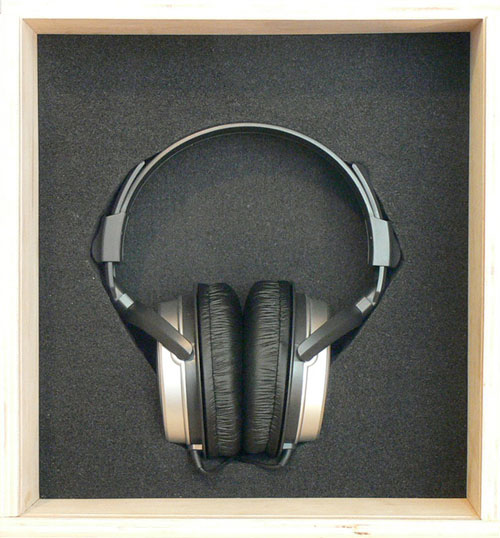
Nothing (for Robert Barry) is ostensibly a tone-cluster sound work (albeit one in the ultra-sonic range) I think of this work as primarily a gallery space empty of insects and rodents. In Untitled (Headset) a pair of headphones is altered so that one earpiece becomes a microphone, picking up its own sound from the speaker and creating a continuous feedback loop, which is disrupted by attempts to listen closer. The silence serves as a blunt metaphor for the inability to understand infinity (your head gets in the way).
Dave Dyment is a Toronto-based artist who often uses silence and dormant sound in his work. He has produced video, photographs, performances, neon, LED, billboards, artist's books, records, multiples, one-hundred year whisky and LSD. Recent projects include Water Music (Electric Eclectics Festival), Is It What It Is and Other Questions (Power Plant) and The Day After, Tomorrow (Nuit Blanche). His audio works can be heard on the anthology/CD compilation Aural Cultures (YYZ Books) and on New Life After Fire (Art Metropole), a collaboration with Lee Ranaldo of Sonic Youth. Dyment is represented by MKG127.
----------------------------------
Darsha Hewitt
Electrostatic Bell Choir, 2012
Electromechanical installation, 20 prepared cathode ray tube (CRT)
television monitors, 20 electrostatic bell sets, custom made
electronics - variable dimensions
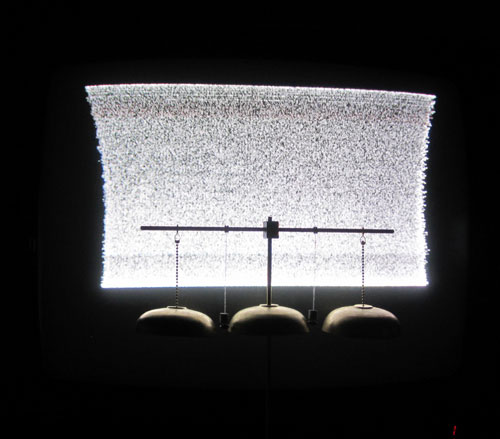
Electrostatic Bell Choir consists of 20 Cathode Ray Tube TVs that are repurposed and used as static electricity generators. The TVs turn on and off in automated sequences and accumulate static build up on the screens. These charges agitate small strikers on a series of small bell assemblies sitting in front of the monitors, causing them to
waver and lightly hit the bells. The glow of the screens and the subtle resonance of the bells magically punctuate the dark surroundings of the installation.
Darsha Hewitt is a Canadian artist based in Montreal. She has presented artwork across Canada, in Mexico, Scandinavia and Europe. She is the recipient of an International Stipend for Young Artists in Sound Art from the Federal State of Lower Saxony and Braunschweig HBK (DE) (2013). She has presented at Make Art Festival (FR), Piksel Festival (NO), La Periferia (MX), MUTEK (CA), Elektra - BIAN (CA), Studio XX (CA) and Interacess (CA). In keeping with her interest in making technology accessible, she teaches do-it-yourself electronics workshops in artist-run organizations, youth centres, schools and with feminist groups. Hewitt takes part in several open-source technology communities. Her work is represented by Perte De Signal (QC).
----------------------------------
Alexis O'Hara
SQUEEEQUE! The Improbable Igloo,
2009
+/- 3m diameter 1.5m height. Recycled speakers, wire, xlr cable, microphones, 1/4" cable, effect unit, mixer, LED light organ, amplifier, pillows!

This speakerbox dome is a proposal for collaborative soundmaking by ephemeral bands of vocalists.
Alexis O'Hara is an undisciplined artist interested in fort-building, feedback and allegories of the human voice. She lives & works in Montreal.
----------------------------------
John Oswald
Whisperfield,
2002
66 minutes
Whisperfield is the independent, non-synchronous soundtrack accompanying, on CD, the commercial DVD Arc d'Apparition (published by OHM/Avatar, directed by Oswald). The sound is of individual and sometimes multitudinous whisperers each describing their appearance in their native tongue, about eight languages in all.
John Oswald is a composer, mediartist, director and designer, with a side history as an improvisor on the alto sax and in dance. He is perhaps best known as the creator of the music genre Plunderphonics, an appropriative form of recording studio creation which he began to develop in the late sixties. Oswald is a Governor General Award Media Arts Laureate, Ars Electronica Digital Musics and Untitled Arts Award winner, and an inductee into the CBC Alternative Walk of Fame, as well as being nominated to third place in a list of the most internationally influential Canadian musicians, tied with Celine Dion.
----------------------------------
Ian Skedd
Sign Singing: Love Will Tear Us Apart, Joy Division, 1979, Deaf Choir, 2009,
2009
Single Channel Video,
4min 19sec

Sign Singing: Love Will Tear Us Apart, Joy Division, 1979, Deaf Choir, 2009 explores the translation of the rhythm and emotion of a seminal pop song into sign language, a silent, visual and gestural form of communication. The choir was formed with 12 individual members of Vancouver, BC’s deaf community in order to create a signed interpretation of British post-punk band Joy Division’s 1979 single Love Will Tear Us Apart, matching the cadence of the original song to sign motions that capture its emotional meaning. This song, which became a brooding anthem for the post-punk generation, was written by the band’s vocalist Ian Curtis—whose onstage performance was extremely gestural—and was the band’s first chart hit. In Sign Singing, sound is expressed through an inaudible form of communication. Visually, the choir’s hands, bodies and facial movements become the only readable aspects of the song. Silence – rather than sound – is emphasized, yet when engaged with the motions of the choir, the familiarity of the song takes hold.
Ian Skedd is a multi-disciplinary artist living and working in Vancouver, BC. He studied at Emily Carr Institute of Art and Design, Vancouver and received his MFA from Chelsea College of Art and Design, London UK in 2009. His practice focuses on psychological and conceptual relationships to space, incorporating a wide reaching interest in performative actions, as well as the psychological process of decoding information. His work has been shown in solo and group exhibitions including Gallery Fukai, Triangle Space, Western Front, Charles H. Scott Gallery, Contemporary Art Gallery, Artspeak, Galerie Werner Whitman, among others.
----------------------------------
Charles Stankievech
Get Out of My Head, Get Out of My Mind,
2008
Stereo Sound with Wireless Headphones,
6min loop
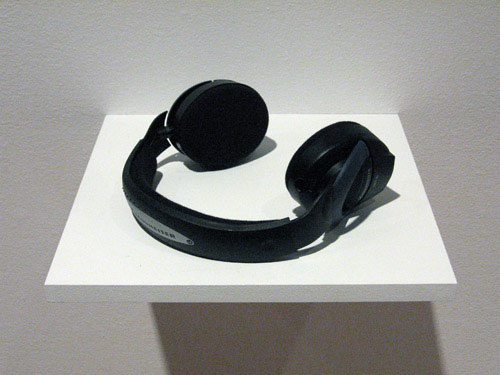
Working from Bruce Nauman’s Get Out of My Mind, Get Out of This Room (1968), I covered the piece but within the new context of virtual architecture and disembodied subjectivity. Unlike Nauman’s original, the new work Get Out of My Head, Get Out of My Mind (2008) denies hard architecture and explores the unique relation between virtual space and psychotopology.
Charles Stankievech (1978, Canada) creates fieldworks. His diverse body of work has been shown at such places as the Palais de Tokyo (Paris), International Symposium on Electronic Arts (ISEA2010, Germany), dOCUMENTA13 (Kassel), Xth Biennale of Architecture (Venice), NGBK + HKW (Berlin), Eyebeam + ISSUE Project Room (New York), Musée d’art contemporain Montréal, Canadian Centre for Architecture and MASSMoCA. He has curated such unorthodox exhibitions as Magnetic Norths, A Wake For St. Kippenberger’s MetroNet, and the series OVER THE WIRE. His writings range from academic journals, such as Leonardo Music Journal (MIT Press) and 306090 (Princeton Architectural Press), to experimental texts for art publications. Since 2011, he is co-director of the art and theory press K. located in Berlin. A founding faculty member of the Yukon School of Visual Arts in Dawson City, Stankievech splits his spacetime between the Yukon and Berlin.
Art Work Exhibition Rights: Collection of the Artist
Photographic Rights for Supplied Photograph: Photo: Paul Litherland, courtesy Leonardo and Bina Ellen Gallery & Charles Stankievech
----------------------------------
Mitchell Akiyama
Ur-sound, or, the noise no writing can store, 2012
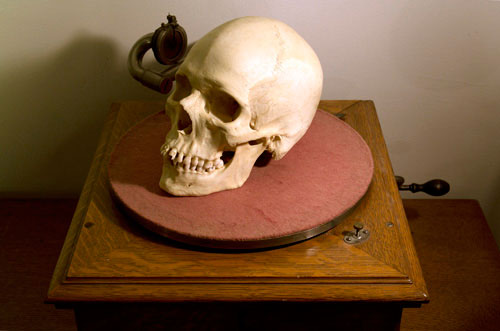
The poet Rainer Maria Rilke once imagined running the needle of a gramophone through the coronal suture of a human skull—a jagged furrow that he likened to the grooves of a gramophone record— an act he imaged would activate what he called the “primal sound.”
Mitchell Akiyama is a Toronto-based composer, artist, and scholar. He has performed and exhibited his sound works and installations throughout North America, Europe, Japan, and Australia. Akiyama has received commissions from Akousma, Le Nouvel Orchestre d’Aujourd’hui, and the Canada Council for the Arts, among many others. He hold an MFA from Concordia University and is currently pursuing a PhD in Communications at McGill University.
----------------------------------
crys cole
sweeper,
2009
Audio-video work,
16:58 min.
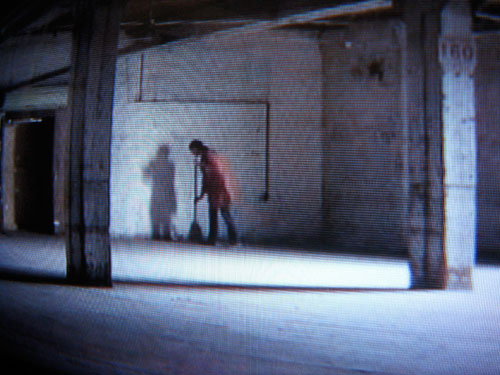
sweeper is a meditation on the banal chore of sweeping. The exaggerated soundtrack, captured by a contact microphone in the bristles of the broom, distorts and amplifies the artist's gestures, altering our perception of this ordinary activity.
crys cole is a Canadian sound artist working in performance and installation. Active listening is the fundamental core of her practice. By drawing out subtle and imperfect sounds through simple meditative gestures she aims to concentrate the listeners focus and in turn, reveal the broader sound environment that exists around and within us. She has worked extensively in live improvisation settings and has performed and shown work across Canada, Europe, Japan and in the USA.
----------------------------------
Marla Hlady
Basement Bass (Justina M. Barnicke Gallery),
2013
Dimensions variable
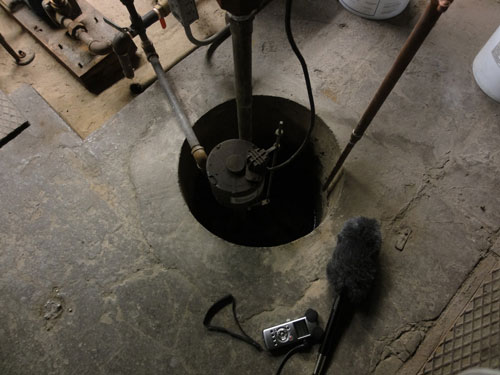
Basement Bass (Justina M. Barnicke Gallery) is an audio architectural work that turns a floor into a rotating, resonating, bass speaker. When viewers walk on the floor, they feel the audio through their bodies more than they hear it through their ears. Audio from the sub basement below the gallery (the bass-basement of the building) is my sounding (source) material.
Marla Hlady draws, makes sculpture, works with sites and sounds and sometimes makes video. Hlady's kinetic sculptures and sound pieces often consist of common objects (such as teapots, cocktail mixers, jars) that are expanded and animated to reveal unexpected sonic and poetic properties often using a system-based approach to composition. She currently lectures at the University of Toronto. She has mounted site works in such places as the fjords of Norway, a grain silo, an apartment window, a tour bus, the Hudson’s Bay department store display window, an empty shell of a building, a roof top. Marla Hlady lives and works in Toronto and is represented by Jessica Bradley Gallery.
----------------------------------
Neil Klassen
Requiem and Ruin #1,
2011
trumpet and tar
Requiem and Ruin #2,
2011
Digital Print mounted on brass
28 x 43 inches
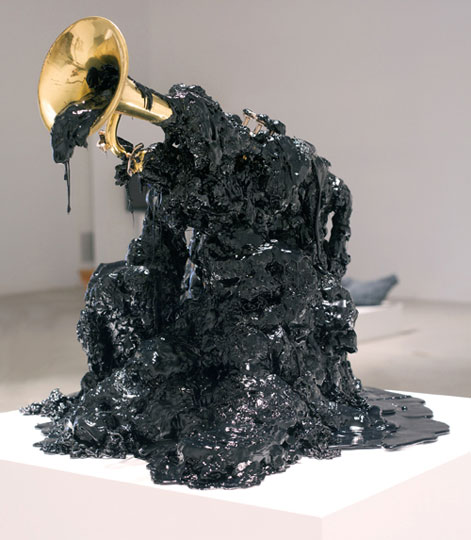
Drawing from an innate interest in human nature, my work explores the conditions that determine and influence a sense of self and place on earth. Requiem and Ruin examines the relating landscape to the preserved surfaces of the built environment. An awareness of the ephemerality of our constructions and their incorporation within systems of the natural world is at the centre of this project as it questions the balance between natural and industrial while conveying the friction between value and preservation.
Neil Klassen is a London-based interdisciplinary artist whose practice encompasses sculpture, photography and drawing. Investigating subjects ranging from the political and environmental crises, to the intertwined nature of spiritual and physical experiences, he seeks to convey tensions between vulnerability & aggression, innocence & seduction, and life & death. Neil holds an MFA from Western University, and a BFA from OCADU. He currently teaches Drawing & Painting at Western University.
----------------------------------
David Lieberman
performance, performity, performativity, 2008 - 2012
Spoken word, 19 mins,
600mm diameter table and chair

The reading will be presented as either live performance or as an audio recording. The text is a poetic meditation on aurality and sound exploring the limits of spatial containment and understanding as a fundamental principle in architectural composition. Experiential time, durational time, and mimetic time all figure in the speculative musings of architectures yet to be constructed. Critical commentary is balanced with proposition as defining space in its ability to contain, to bound, to reflect and to allow sound to bleed to the edges of inaudibility. Each day at a given time, a table and a chair are placed in the gallery for the artist to read and to write. On the table is a sketchbook filled only with sounds, drawing instruments, a surveyor’s compass, a thumb piano, a copy of a handmade book, a bottle of Aquavite, a glass and an espresso cup. On completion of the reading, the set pieces are removed leaving only the ephemeral presence and the material physicality of sounds that may or may not have been heard.
Educated in architecture, sculpture, and industrial design, David Lieberman has been a practicing architect since 1974. He is an Associate Professor at the John H. Daniels Faculty of Architecture Landscape and Design, University of Toronto and has a long term adjunct appointment at the School of Architecture, University of Waterloo. Recent publications include research on responsible and sustainable architectures, speculative and constructed landscapes, and critical works on music, acoustics and architecture. He is a member of the planning committee for the soundaXis festival of New Music and a board member of the Music Gallery. David Lieberman is not a musician, but has enjoyed the pleasures of music and is constantly challenged by the space between notes.
----------------------------------
Rafael Lozano-Hemmer
Last Breath, 2012
Apparatus 60 x 27.5 x 23 cm, tube up to 15 m long. Weighs 8Kgs. Materials/Technique: Motor, bellows, plexiglass, digital display, custom circuitry, arduino processor, respiration tubing, brown paper bags

Last Breath is an installation designed to store and circulate the breath of a person forever. The piece consists of a small brown paper bag which inflates and deflates automatically thanks to motorized bellows similar to those found in artificial respirators in hospitals. The apparatus hangs on a wall and is activated 10,000 times a day, the typical respiratory frequency for an adult at rest, including 158 sighs. Each stroke of the machine advances a digital counter that beeps. The breath circulates between the bellows and the paper bag through a ribbed transparent plastic tube that emits a faint and hypnotic low sound. The brown paper bag makes a rhythmic crushing sound as it inflates and deflates.
Rafael Lozano-Hemmer is a Mexican-Canadian artist. In 2007 he was the first artist to officially represent Mexico at the Venice Biennale. He has also shown at Biennials in Sydney, Liverpool, Shanghai, Istanbul, Seville, Seoul, Havana, New Orleans, Singapore and Moscow. His public artwork has been commissioned for events such as the Expansion of the European Union in Dublin, the memorial for the Tlatelolco student massacre in Mexico, the 50th anniversary of the Guggenheim Museum in New York and the 2010 Winter Olympics in Vancouver. His work is in collections such as MoMA in New York, Jumex in Mexico, Daros in Zürich and TATE in London.
----------------------------------
Sylvia Matas
In Every Direction,
2011
Deconstructed bookwork/ 5.875 x 7 x .75 in (44 pages), digitally printed and mounted on wood
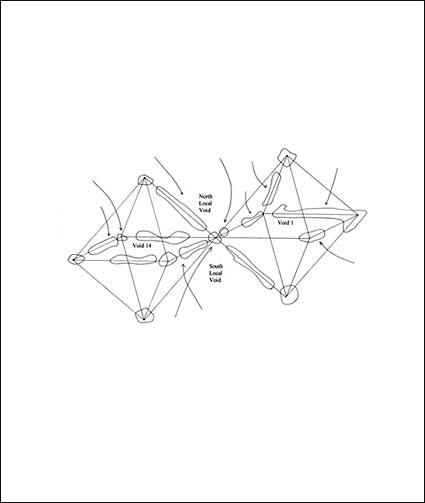
In Every Direction consists of images and text. There is no narrative—it is more of an incomplete collection of information that describes overlapping mental and physical environments. There are references to (among other things) sound and movement through time and space, in and out of intensity and in and out of focus.
Sylvia Matas is an interdisciplinary artist. She grew up in Winnipeg, and after living in China, Montreal and London (where she received her MFA in 2008) she has returned home. Her work has been exhibited both locally and internationally, most recently at AKA Gallery (Saskatoon), Plug In ICA (Winnipeg) and Uturdur (Reykjavik).
----------------------------------
David Merritt
untitled (here), 2007
graphite and watercolour on paper
64.25 x 56.25 inches (framed)
Collection of the Artist
untitled (now), 2007
graphite and watercolour on paper
64.25 x 56.25 inches (framed)
Collection of the Artist

Approaching written language as a sign for sound, untitled (here) and untitled (now) are sister drawings that involve the graphic mapping of recorded song titles. Transcribing the titles using an open-ended process of drawing and erasure, the works are playfully organized to glean a game of presence and absence embedded in the titles themselves.
David Merritt’s drawing and multimedia works have been exhibited in galleries nationally and internationally, including the National Gallery of Canada, Art Gallery of Ontario, the Textile Museum of Canada and TENT CBK, Rotterdam. A touring survey and catalogue of his work, shim/sham/shimmy has recently been circulated by Museum London in collaboration with the Art Gallery of Hamilton, the MacLaren Art Centre and the Art Gallery of Windsor. Merritt is based in London, Ontario where he teaches Western University. He is represented by Jessica Bradley, Toronto.
----------------------------------
Ryan Park
untitled (4'33"),
2006
Graphite on book. 8 x 7 x 0.9" (closed)
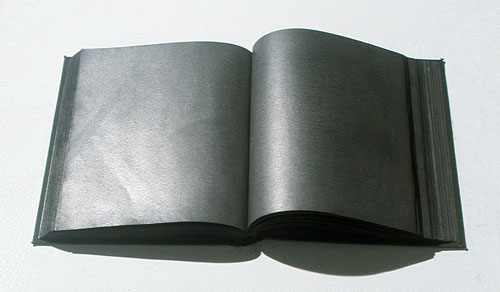
Silence by John Cage, rubbed and buffed with graphite from cover to cover.
Ryan Park uses shared objects, encounters, and cultural touchstones as starting points to produce work that oscillate between serious and playful, clinical and poetic. His interdisciplinary practice results in videos, photographs, and manipulations of found materials that suggest presences and absences, urges and constraints. He currently lives and works in Toronto.
-----------------------------------
Juliana Pivato
Yesterday Wants More,
2013
4 Minutes
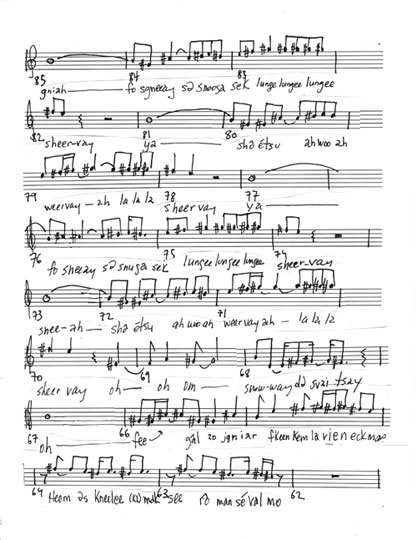
For the duration of the exhibition, I will give a daily performance of the song. On days when I am unable to be at the gallery, the performance will be replaced by a recording. The song is Yesterday Once More, by the Carpenters. I will be performing it backwards and without accompaniment. The work and its live performance was inspired by another work, Yesterday / Today Once More, 2009, by Marc Couroux. The title for this performance was given to me by Holiday Rambler (D. Alex Meeks).
Juliana Pivato holds an MFA in Sculpture from School of the Art Institute of Chicago (2009), a BFA in Studio Arts from Concordia University (2003) and a BMus from McGill University (1998). Recent solo exhibitions include Trading Surfaces at the MacLaren Art Centre, Barrie, 2011 and I want to be here with you, Division Gallery, Montreal, 2010. From 2007–2009 Juliana was the creator and host of Songs from the Loop, a weekly experimental radio show on freeradiosaic.org in Chicago.
----------------------------------
Alexandre St-Onge
L'indécidable crowbar cosmogonique,
2010
Video,
9 mins
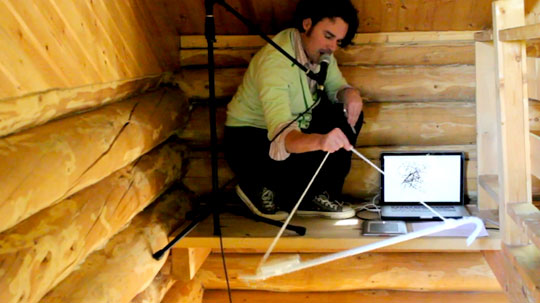
L'indécidable crowbar cosmogonique is a video documentation of different experimentations on the emergence of monstrosity and hermetic entities through the creative process.
Alexandre St-Onge is an audio artist, a musician/improviser (acoustic bass, bass, voice and electronics) and a sound performer. He has studied literature and philosophy and he is currently doing his PhD in art. He is fascinated by creativity as a pragmatic approach of the ineffable. He has released eight solo CDs and plays in numerous bands, including K.A.N.T.N.A.G.A.N.O., Klaxon Gueule, Les esprits frappeurs, Pink Saliva, mineminemine, Shalabi Effect and undo. As a composer he has worked for kondition pluriel, Marie Brassard, Karine Denault, Lynda Gaudreau, Line Nault, Jérémie Niel, Maryse Poulin and Mariko Tanabe.
-----------------------------------
Chiyoko Szlavnics
Moiré Series, 2012
Medium: Ink on paper
8 cm x 33.5 cm x 3 cm
Moiré Series, 2010
Ink on paper
38 cm x 33.5 cm x 3 cm
Not yet titled, 2012
Ink on paper
70 cm x 100 cm
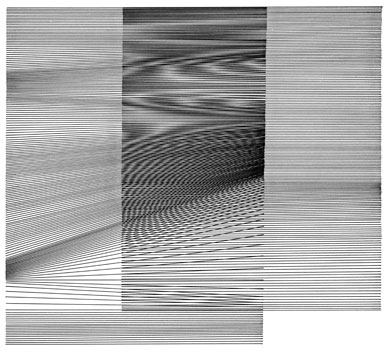
These drawings explore the layering of two to four planes of lines, producing moiré patterns that suggest a third dimension. How these drawings read from far away becomes important, especially how light is reflected of the sections where there are wider spaces between the lines.
The Canadian composer and visual artist Chiyoko Szlavnics has been living in Berlin for the past fourteen years. She graduated from the Faculty of Music at the University of Toronto in 1989. She studied privately with the composer James Tenney in Toronto from 1994-7, and a year later relocated to Berlin. From 2000 onward, her compositional process increasingly tended toward a visual structuring of musical notation on the page, and in 2004, line drawings—which Szlavnics had often used while sketching ideas for compositions—finally became the actual basis for them. Szlavnics continues to practice in both disciplines (composition and visual art), with considerations and observations in each medium continually informing and influencing the other.
----------------------------------
John Wynne
Cold Atlantic,
2007-12
Hearing aids, jewel box, projector. Dimensions variable.

My father died in 2006, leaving behind three pairs of hearing aids and a supply of batteries. This piece makes use of the minute but complex feedback field produced by what is essentially a set of tiny microphones and tiny speakers. The projected photograph was taken by my father somewhere in the mid-Atlantic in 1959 while we were on our way to Canada, where I was to grow up. It was uncharacteristic of him to take such an empty picture, and even more so to label it with the poetic title Cold Atlantic. This small installation is uncharacteristically personal for me: it addresses notions of absence, and for this purpose, feedback could not be more suitable. Feedback’s “tautological elegance” contradicts its status as problem or systemic fault: in this piece, its antagonistic relationship to hearing aids is harnessed to explore the presence of loss.
John Wynne’s practice includes large-scale multi-channel installations for galleries and public spaces, delicate sound sculptures, flying radios and award-winning "composed documentaries." His installation for 300 speakers, player piano and vacuum cleaner became the first work of sound art in the Saatchi collection in London. His work with endangered languages includes a project with click languages in the Kalahari Desert and another with one of Canada’s indigenous languages, Gitxsanimaax. John is a Reader in Sound Arts at the University of the Arts London, a core member of the CRISAP research centre.
In partnership with the Justina M. Barnicke Gallery and generously supported by the Canada Council for the Arts, the Ontario Arts Council, the Hal Jackman Foundation, Hart House, UTM Student Housing and Residence Life and the Department of Visual Studies at the University of Toronto Mississauga.
